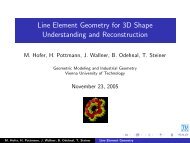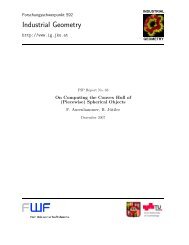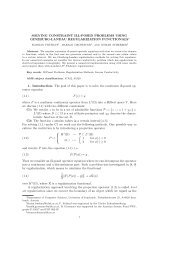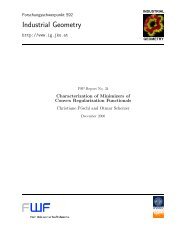Combined evolution of level sets and b-spline curves for imaging
Combined evolution of level sets and b-spline curves for imaging
Combined evolution of level sets and b-spline curves for imaging
Create successful ePaper yourself
Turn your PDF publications into a flip-book with our unique Google optimized e-Paper software.
5<br />
measurements. This result holds <strong>for</strong> inclusions <strong>of</strong> dimension<br />
2 <strong>and</strong> 1.<br />
The actual identification <strong>of</strong> these inclusions by computational<br />
means is an ill-posed inverse problem. Results<br />
concerning the (in-)stability <strong>of</strong> the reconstruction<br />
can be found in [14,1,3,5,4]. We will focus on a <strong>level</strong><br />
set implementation which is similar to [10,12]. This iterative<br />
approach starts with a <strong>level</strong> set function such<br />
that the zero <strong>level</strong> set corresponds to the initial guess<br />
<strong>of</strong> the inclusion. The <strong>level</strong> set function evolves according<br />
to the minimizing gradient flow <strong>of</strong> a regularization<br />
functional. Thus, we have a <strong>level</strong> set <strong>evolution</strong><br />
u k+1 = u k − δ∇F(u k ),<br />
where F is the regularization energy (corresponding to<br />
the EIT problem) <strong>and</strong> ∇F its derivative with respect to<br />
the <strong>level</strong> set function u. Then u k is supposed to converge<br />
to a function ũ in the L 2 sense, such that {x ∈ Ω :<br />
ũ(x) ≥ 0} is the isolating inclusion we seek.<br />
Now assume that this inclusion is a crack, i.e. a<br />
1-dimensional set. Then, it can not be characterized by<br />
a <strong>level</strong> set function <strong>of</strong> class L 2 anymore <strong>and</strong> the above<br />
method will fail. In other words, a <strong>level</strong> set method<br />
which is known to detect inclusions in a conductor in<br />
the L 2 -sense only, does not work <strong>for</strong> cracks anymore,<br />
because 1-dimensional features will be lost with such a<br />
method.<br />
We propose to use a combined <strong>evolution</strong> in the iterative<br />
computation <strong>of</strong> such <strong>level</strong> set functions. It might<br />
allow us to detect the development <strong>of</strong> <strong>level</strong> <strong>sets</strong> <strong>of</strong> dimension<br />
1 in advance <strong>and</strong> to cope with such cases. This<br />
approach is very similar to the case <strong>of</strong> image segmentation<br />
<strong>and</strong> is described in detail in Section 4.<br />
2 The combined <strong>evolution</strong><br />
As in the introduction we assume a gray-scale image<br />
I : R 2 → R <strong>and</strong> an initial <strong>level</strong> set function u 0 . Let<br />
further u : [0, ∞[ × R 2 → R be a solution <strong>of</strong> (1.1) <strong>and</strong><br />
C j : [0, 1] → R 2 , 1 ≤ j ≤ k, simple Jordan <strong>curves</strong>,<br />
which do not intersect each other (or lie within each<br />
other). By I(C) <strong>and</strong> O(C) we denote the regions inside<br />
<strong>and</strong> outside a Jordan curve C : [0, 1] → R 2 . We further<br />
define<br />
I(C 1 , . . . , C k ) = ⋃<br />
1≤j≤k<br />
O(C 1 , . . . , C k ) = ⋂<br />
1≤j≤k<br />
I(C j ) <strong>and</strong><br />
O(C j ).<br />
A slightly modified version <strong>of</strong> the Mum<strong>for</strong>d-Shah functional<br />
[19,20], <strong>for</strong> k <strong>curves</strong> is given by<br />
∫<br />
(<br />
I(C 1 , . . .,C k ) = α u1 − f ) 2<br />
dx<br />
I(C 1,...,C k )<br />
+ α<br />
+ β<br />
∫<br />
O(C 1,...,C k )<br />
k∑<br />
L 2 2(C j ),<br />
j=1<br />
where α, β > 0 <strong>and</strong><br />
∫<br />
u 1 = avg f dx <strong>and</strong> u 2 = avg<br />
Here<br />
I(C 1,...,C k )<br />
(<br />
u2 − f ) 2<br />
dx<br />
∫<br />
avg f dx := 1 ∫<br />
f dx<br />
A |A| A<br />
∫<br />
O(C 1,...,C k )<br />
(2.1)<br />
f dx.<br />
is the average <strong>of</strong> a function f over a set A. The functional<br />
(2.1) is also used in [11].<br />
We want to minimize the above energy functional<br />
by solving the variational problem I → min. Assume<br />
that C 1 ′, . . . C′ k<br />
are <strong>curves</strong> <strong>of</strong> minimal energy. Then the<br />
function<br />
u ′ = u 1 χ I(C1,...,C k ) + u 2 χ O(C1,...,C k )<br />
is a piecewise constant function, which is discontinuous<br />
along the boundaries <strong>of</strong> C j only <strong>and</strong> approximates u in<br />
the L 2 sense.<br />
Differentiation <strong>of</strong> I(C 1 , . . . , C k ) with respect to C j ,<br />
1 ≤ j ≤ k, yields the following gradient descent:<br />
∂C j<br />
∂τ (τ) = −∇I( C j (τ) ) , 1 ≤ j ≤ k , (2.2)<br />
where<br />
−∇I ( C ) ( (u2<br />
= α (C) − u ◦ C ) 2<br />
− ( u 1 (C) − u ◦ C ) 2 ) |C ′ |n j<br />
+ β|C ′ |C ′′ ,<br />
(2.3)<br />
<strong>for</strong> a curve C. Here ∇I is the derivative <strong>of</strong> the energy<br />
functional I in (2.1) with respect to C. Although we<br />
denote it by ∇I, it can not expressed as a matrix since<br />
I is defined on an infinite-dimensional space.<br />
Note that we include the derivative <strong>of</strong> C with respect<br />
to the curve parameter t in ∇I(C). I.e. the directional<br />
derivative <strong>of</strong> the functional I in C into the direction D<br />
can be computed by simply integrating ∇I(C) · D over<br />
the parameter interval [0, 1],<br />
DI(C)(D) =<br />
∫ 1<br />
0<br />
∇I(C)(t) · D(t)dt .







